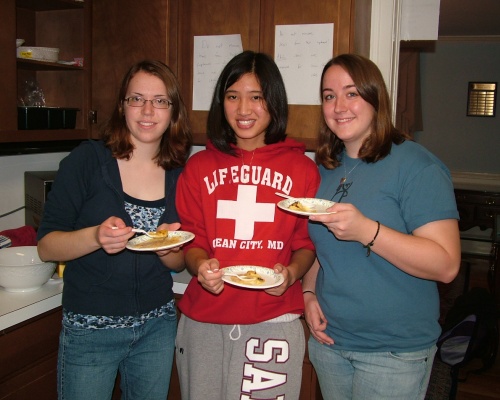Honors Students Get a Taste of Chemistry Through Cooking
Group members took turns using intense heat from a torch to caramelize the sugar topping on their crème brûlée. Pictured (L-R) are Amy Sturtevant of Jarrettsville, Anh Nguyen of Potomac, and Jordan Estes of Ellicott City.
SALISBURY, MD---Crème brûlée, anyone? Three Salisbury University honors students recently whipped up traditional and pumpkin versions of this rich French custard for an assignment in their “Chemistry of Food and Cooking” class.
When mixing ingredients, the team was careful to slowly add the hot cream sauce to the cold sugar and egg yolk mixture—not the other way around, to prevent a rapid temperature change and curdling.
This is just one scientific process students learned this semester during their hands-on investigation of chemical and physical changes that occur during cooking. Each week, a group explored food composition by preparing a recipe in the Bellavance Honors House kitchen for classmates to savor.
“They are really learning what processes lead to better preparation in the kitchen,” said Dr. Miguel Mitchell of SU’s Chemistry Department, creator of the new interdisciplinary honors seminar. “A lot times, people are scared of cooking, but if you know how things work and why things happen, then you aren’t as worried about messing up.”
For example, when baking chocolate chip cookies, why should butter be softened, not melted? The students know that changing the matter to liquid results in flat, greasy cookies, but as a solid it creates air bubbles, producing nice, crispy cookies. And when it comes to muffins, they’ve also learned that wet and dry ingredients should be mixed separately in a specific order or else proteins will make the batter tough.
“The context of what is going on with the molecules really helps you understand what you can and can’t do,” said Mitchell, who loves cooking and makes everything from lactose-free ice cream to international foods with his wife.
Once the crème brûlée was in the oven, he showed the group how to whip leftover egg whites into a meringue. “When you whip them, the proteins create a matrix that traps air,” junior Jordan Estes explained.
Eventually, the group tackled the last step of making a delicious crème brûlée: sprinkling sugar on top and burning it. “This browning is caused by a ‘caramelization’ reaction which involves sucrose, water and heat,” sophomore Anh Nguyen said.
Other groups have attempted a chocolate soufflé, orange-cranberry glazed muffins, liquid nitrogen ice cream, tomato soup with bread, and crêpes. Sophomore Kristie Bon prepared a Spanish quiche, which actually turned into a scrambled egg medley after her group realized they didn’t allow enough prep time to chop vegetables. A self-proclaimed “bad cook,” Bon took the class figuring it would help improve her culinary skills.
“Our first exam was actually interesting,” she said. “We had to identify 20 herbs and spices by smell.” She passed the sensory test with 17 correct.
Students are also learning about the inventive culinary movement of “molecular gastronomy” through Harold McGee’s On Food and Cooking: The Science and Lore of the Kitchen.
“This is the most unique class I’ve taken here at Salisbury because you learn about something that you can go out and apply in real life on a daily basis,” said Nguyen, especially since students were responsible for everything from grocery shopping to washing dishes.
“This class is different from others because we get to eat our experiments and I have enjoyed every morsel,” sophomore Amy Sturtevant said. “We learn about chemistry that is relevant to our everyday lives and it makes me appreciate food in a whole new way.”
For more information call 410-543-6030 or visit the 成人抖阴Web site at www.salisbury.edu.

